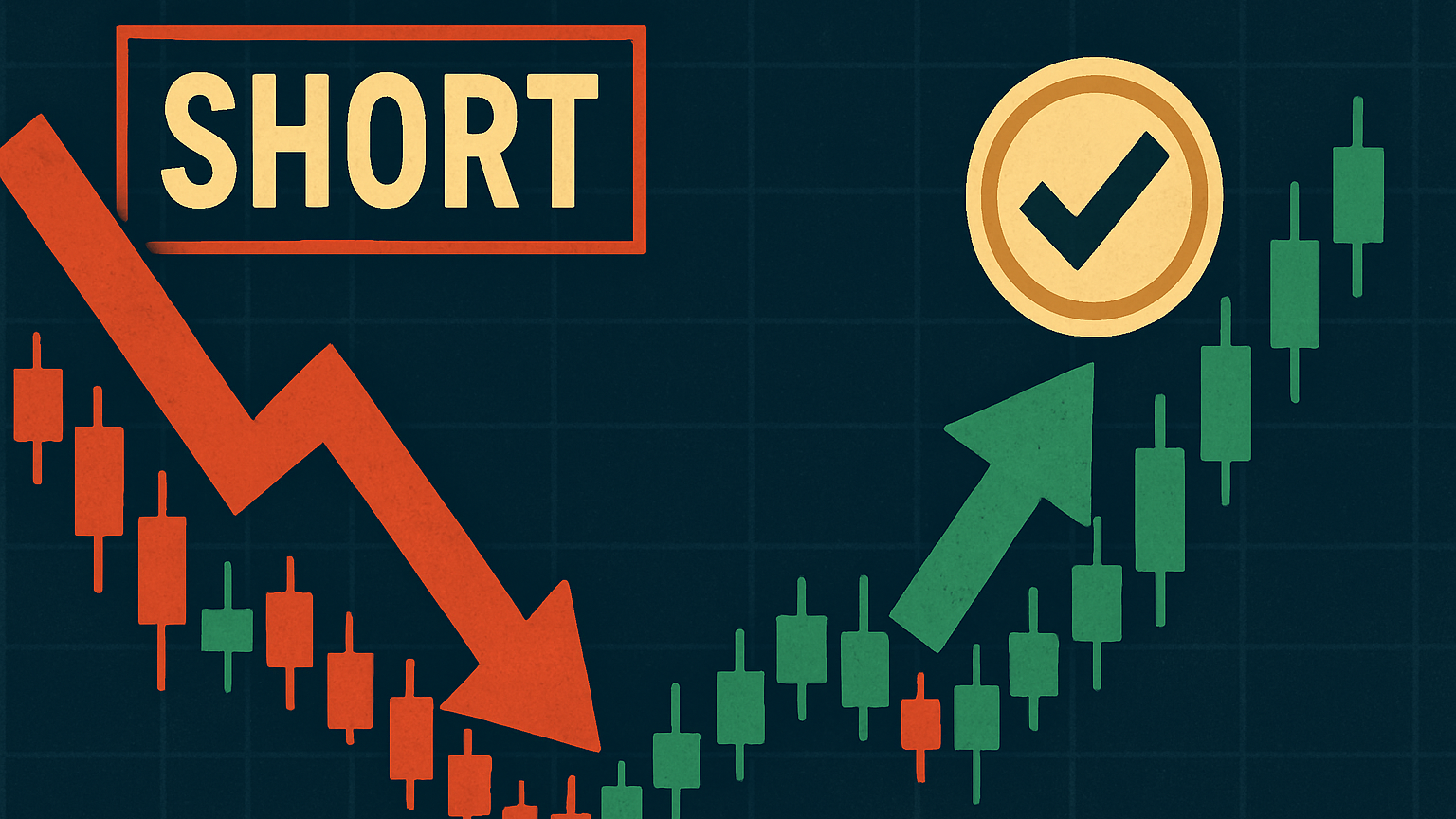Explore the cup and handle pattern, its success rates, key features, and tips for maximizing trading returns over different time frames.
The cup and handle pattern is a reliable bullish continuation pattern often leading to ongoing upward trends. It forms in two phases: a U-shaped "cup" (1-6 months) and a downward-sloping "handle" (1-4 weeks). Success rates improve over time, with 70% for 1 year, 80% for 5 years, and 85% for 10 years.
Key Highlights:
- Ideal Measurements: Cup depth at 38.2%-61.8% of the prior trend, handle slope at 10-15%.
- Volume Trends: Declines during the cup, rises during recovery, spikes at breakout.
- Fibonacci Levels: Handles staying above the 50% retracement level are more reliable.
- Risk-Reward: Offers a 2.5:1 return-to-risk ratio.
Pro Tip: Look for clear volume confirmation and align with the broader market trend for better results.
Key Features of the Cup and Handle Pattern

How the Cup Forms
The cup takes shape as a U-shaped recovery following a decline. Ideally, it has a smooth, rounded bottom rather than a sharp V-shape. For better reliability, the cup's depth generally falls between 10-30% of the pattern's height [2].
During this phase, volume decreases as selling pressure fades, then begins to rise as buyers re-enter the market. These volume patterns help confirm the validity of the formation [2][3].
How the Handle Forms
The handle appears as a downward-sloping consolidation phase after the cup is complete. It typically slopes down by 10-15%, lasts 1-4 weeks, and stays within the upper half of the cup. The handle's depth should not exceed 50% of the cup's depth [2][3].
This handle phase reflects short-term profit-taking before a potential breakout. Prices generally remain above the 50% Fibonacci retracement level of the cup's depth during this time [2][3].
Volume Trends in the Pattern
Volume plays a critical role in confirming the pattern. It usually declines during the cup's descent, reaches its lowest point at the bottom, and then rises as the recovery begins. For the handle, volume decreases again but spikes sharply during the breakout [2].
When these volume trends align with the pattern, they serve as a strong indicator of its reliability for predicting future price movements [2][3].
Although these characteristics define the pattern, external market factors can impact its effectiveness as a predictive tool.
Factors That Affect the Pattern's Reliability
Time Taken to Form the Pattern
The time it takes for the cup and handle pattern to form plays a big role in its reliability. Generally, the cup forms over a period of 1 to 6 months, while the handle takes about 1 to 4 weeks. Longer formation periods often suggest stronger accumulation and a more reliable setup. On the other hand, patterns that form too quickly might indicate weaker signals [2]. A gradual formation helps filter out false setups.
Ideal Depth and Length
The depth and length of the pattern are also key indicators of its strength. Ideally, the cup's depth should fall between 38.2% and 61.8% of the previous uptrend, reflecting a healthy correction [2]. The handle should stay in the upper half of the cup and avoid dropping below the 50% Fibonacci retracement level. A slight downward slope of about 10-15% in the handle shows proper consolidation [2].
| Pattern Component | Ideal Measurements |
|---|---|
| Cup Depth | 38.2%-61.8% of previous uptrend |
| Handle Slope | 10-15% downward |
| Handle Position | Above 50% of cup's height |
Role of Retracement Levels
Fibonacci retracement levels are crucial for confirming the pattern's validity. Handles that remain above the 38.2% Fibonacci level are more likely to result in successful breakouts [2]. If the handle falls below and closes under the 50% retracement level, it often signals weakness in the pattern and a higher risk of failure. Traders can use these levels to identify setups with better odds.
While these factors are important for assessing reliability, looking at historical data can offer additional insights into the pattern's overall effectiveness.
Historical Success Rates of the Cup and Handle Pattern
Success Rates by Time Frame
The cup and handle pattern tends to perform better over longer time frames. For short-term trading (1 year), it has a 70% success rate, while medium-term trading (5 years) sees this rise to 80%, and long-term trading (10 years) achieves 85% success [1].
| Time Frame | Success Rate |
|---|---|
| Short-term (1 year) | 70% |
| Medium-term (5 years) | 80% |
| Long-term (10 years) | 85% |
These figures offer a general perspective, but results can vary depending on market conditions and asset types.
Market Conditions and Other Factors
The effectiveness of this pattern relies on a few critical factors: it should align with the primary trend, display proper formation characteristics, and show increasing volume during the handle phase. A shorter handle duration often signals a stronger setup, as it suggests a quicker continuation of the uptrend after consolidation [2].
Key elements for success include:
- Following the primary market trend
- Meeting ideal pattern formation criteria
- Volume confirmation during the handle phase
Performance in Stocks, Crypto, and Forex
The cup and handle pattern behaves differently across asset classes like stocks, cryptocurrencies, and forex. Tools like LuxAlgo’s indicators and volume analysis can help traders pinpoint high-probability setups and confirm the pattern's validity. With a return-to-risk ratio of 2.5 to 1 [4], this pattern offers a solid framework for managing positions.
To validate the pattern, traders should focus on:
- Volume trends: Ensure volume supports the pattern's formation.
- Price action: Look for a clean and well-defined pattern.
- Technical tools: Use additional indicators to confirm breakout signals.
Tips for Using the Pattern in Trading
Finding Entry and Exit Points
The pattern boasts historical success rates of up to 85% over long-term timeframes, making precise entry and exit strategies critical for maximizing returns. The ideal entry point occurs when the price breaks above the handle's resistance, confirmed by strong trading volume [2]. For exits, aim for a 2.5 to 1 return-to-risk ratio. Set a stop loss just below the handle's low to guard against potential false breakouts [4].
Using Volume to Confirm Trades
Volume analysis plays a key role in verifying cup and handle patterns. Here's the typical volume behavior during each stage:
| Pattern Stage | Expected Volume |
|---|---|
| Cup Formation | Decreasing |
| Cup Bottom | Low |
| Right Side of Cup | Increasing |
| Handle Formation | Lower than the cup |
| Breakout | Higher than average |
During consolidation phases, volume usually declines, while breakouts are marked by a volume spike. This surge in volume confirms buying interest, increasing the chances of a successful trade [2][3]. Platforms like LuxAlgo offer advanced tools to simplify volume tracking and confirm pattern validity.
How LuxAlgo Can Help

LuxAlgo provides a powerful suite of tools designed to help traders analyze cup and handle patterns with ease. Their volume analysis features allow traders to monitor volume trends throughout the pattern's development. Additionally, the platform's trend analysis tools help confirm whether the pattern aligns with the broader market direction.
Whether you're trading stocks, crypto, or forex, LuxAlgo's tools are adaptable to various market conditions. Some of their standout features include:
- Volume profile analysis to assess the strength of the pattern.
- Fibonacci retracement tools from Price Action Concepts that automatically highlight key levels, such as the 38.2% to 50% range, for validating the handle [2].
- Backtesting capabilities to evaluate how the pattern performs in different scenarios.
LuxAlgo integrates seamlessly with TradingView, enabling traders to monitor multiple timeframes. This alignment with long-term strategies supports the 85% success rate tied to these patterns. By leveraging these tools, traders can better identify and act on high-probability opportunities.
Conclusion and Final Thoughts
Key Points Recap
The cup and handle pattern works best on longer timeframes, with success rates as high as 85% over a 10-year span. This reliability comes down to three main factors: the proper duration for formation (1-6 months for the cup, 1-4 weeks for the handle), retracements staying within Fibonacci levels, and specific volume patterns confirming the breakout [2].
To validate the pattern effectively, traders should prioritize:
- Matching the pattern with the overall market trend
- Watching for clear volume spikes during breakouts
- Ensuring the handle forms above the 50% retracement level
- Using stop-loss levels to manage risk
Advice for Traders
For better results, focus on long-term charts where the pattern's reliability is highest. The risk-reward ratio of 2.5:1 offers a solid foundation for managing trades [4]. Success rates improve when traders:
- Track the pattern's progress across different timeframes
- Wait for clear volume confirmation before entering a trade
- Follow strict risk management rules
- Steer clear of trades during highly volatile periods
LuxAlgo's tools can simplify the process by confirming cup and handle patterns through volume analysis and Fibonacci retracement levels. When combined with disciplined risk management, these tools make it easier to integrate this pattern into your trading approach with confidence.
FAQs
This section answers common questions about the cup and handle pattern, focusing on its performance and trading probabilities.
What are the success rates and odds of the cup and handle pattern?
Analysis of over 3,000 patterns reveals that the cup and handle pattern has a baseline success rate of 49% [4]. However, as mentioned in the Historical Success Rates section, this rate improves significantly over longer timeframes, reaching as high as 85% over 10-year periods [1].
The pattern's appeal lies in its return-to-risk ratio of 2.5:1, meaning potential profits significantly outweigh potential losses [4]. Even with a 49% success rate, this ratio can lead to consistent gains over time. Traders can boost their success by:
- Using higher timeframe charts, where the pattern tends to perform better
- Verifying patterns with appropriate volume trends, as explained earlier
- Applying Fibonacci retracement techniques, as previously discussed
- Practicing disciplined risk management strategies







